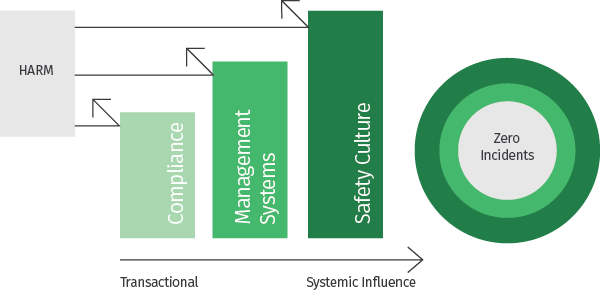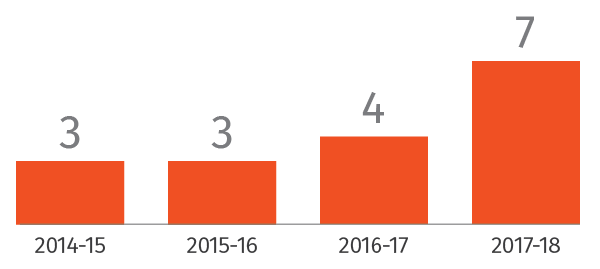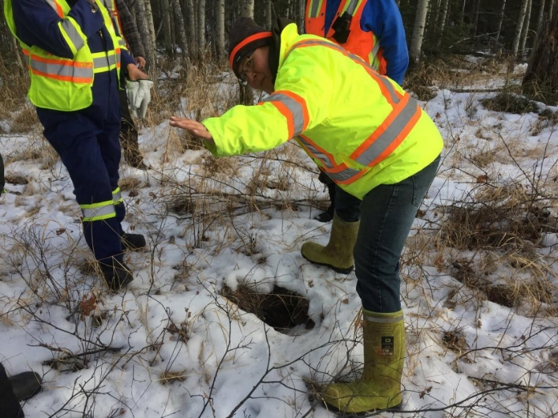Safety and Environmental Oversight
The NEB sets and enforces regulatory expectations for NEB-regulated companies over the full lifecycle – construction, operation and abandonment – of energy-related activities.
Our Commitment
Harm to people or the environment, through the lifecycle of energy-related infrastructure, is prevented.
The NEB takes a three-tiered approach to preventing incidents that harm people or the environment:
- Transactional – risk informed Compliance Verification Activities (CVAs)
- Systemic – management system improvement to control risks and hazards
- Cultural – influencing safety culture and the human factors that are foundational to reducing incidents
Safety and Environmental Oversight Activity in 2017-18:
- 301 Compliance Verification Activities, including:
-
 12 Emergency Management Exercises
12 Emergency Management Exercises -
 147 Inspections
147 Inspections -
 8 Management System Audits
8 Management System Audits -

 4 Financial System Audits
4 Financial System Audits
Preventing Harm
First, we undertake extensive, risk-based Compliance Verification Activities (CVAs) to determine company compliance with regulatory requirements. Compliance is a snapshot in time and although it is a necessary defence against harm, it has very transactional focus. It does give us company specific data that informs our risk models and identifies where compliance oversight is the most effective and has the highest probability to prevent harm. Based on the risk-informed model we have also increased CVAs that would contribute to reducing worker safety incidents. CVAs include technical areas of security, environmental protection, pipeline integrity, safety management, emergency management, security management, damage prevention, rights and interests, and financial regulations.
Secondly, management systems are a key defense against harm and go beyond transactional compliance. Companies are required by NEB regulations to have a management system that identifies and controls hazards and risks. We look for data and trends in incidents and non-compliances to focus our efforts on improving management systems via controls that fix the root causes and mitigate the hazards. We work with a broad range of stakeholders to identify and continually improve regulatory requirements for companies in terms of their management systems, and we audit companies with respect to their compliance with these requirements.
Third is influencing Safety Culture and ultimately industry performance. A company that has a strong safety culture scrutinizes every decision to ensure the risks are managed and harm is prevented. The NEB does not regulate safety culture but we do expect companies to promote a positive safety culture. We also exercise influence by collecting, analyzing and sharing industry wide data and information and to identify learnings related to safety culture that we share formally and informally.
The NEB has established a comprehensive framework to ensure pipeline companies have the funds required to safely abandon their facilities when it is time to do so. All NEB-regulated companies either have a financial instrument on file with the NEB for the full amount of their abandonment cost estimate, or have established a trust where money is set aside to fund future abandonment work. This way, the NEB, landowners, Indigenous communities and the Canadian public can be assured that sufficient funds will be available to conduct abandonment work while protecting the environment and the safety of people. To learn more, please see Appendix G, or visit our Company Performance information at neb-one.gc.ca.
Working with Industry to advance safety culture
The NEB is committed to strengthening and improving industry wide performance as well as our own performance in the area of safety culture. In February 2018, the NEB hosted a safety culture workshop with a number of regulated companies. This pilot initiative was developed to promote a culture of learning and sharing across industry, and between the NEB and its regulated companies.
Conversations throughout the day focused on challenges, successes, and best practices in the advancement of a positive safety culture to improve safety and environmental outcomes across industry. Feedback from attendees confirmed that the workshop was a valuable experience for participants overall and demonstrated the NEB’s commitment to working with operators to improve safety culture. The workshop also allowed the NEB to understand our effectiveness in promoting the importance of safety culture, including looking at how our own oversight culture may be impacting industry efforts.
To positively influence safety culture, we must consider how our organization’s values affect our decision-making and behaviours. This workshop was a great opportunity to understand and reflect on our internal culture for regulatory oversight.Keith Landra, NEB Chief Safety Officer
Number of incidents related to NEB-regulated infrastructure that harm people or the environment.
- Target 0
- Results
2016-17 16 - Results
2017-18 17
Percentage change of specific incident types on NEB-regulated infrastructure:
- Target 10% decrease in incidents
- Results
2016-17 11% increase - Results
2017-18 10% increase
The NEB always aims to achieve zero incidents that harm people or the environment associated with our regulated activities. But we also know that on 72,126 kms of regulated pipeline, the target of zero incidents is difficult to achieve. So in addition to seeking a reduction (elimination) of the prevalence of incidents occurring, as a regulator, we also want to effect a decline in the severity and consequence of incidents, should they occur. This is why we focus our efforts on reducing the number of incidents that harm people or the environment. We know (from our experience, data and industry feedback) that the risk of these incidents, specifically injuries and fatalities, increases when major construction activity increases.
The two indicators above are intended to be read together. The first looks at the total number of incidents per year. And, because we know that the numbers can vary greatly from year to year, the NEB also tracks the three-year rolling average, to better assess long-term changes. The total number of incidents that harmed people or the environment last year was 17; up from 16 the year before. The three-year rolling average also increased by 11% compared to the previous year. The NEB takes any incident very seriously – and has targeted its compliance and enforcement activities and other oversight activity (e.g., outreach, information sharing, etc.) for the coming year on three incident trends: worker safety during construction activities, unauthorized activities or near misses, and operating beyond design limits.
On the two major pipeline projects currently under construction (the TMEP and Enbridge Line 3 Replacement), we have increased our inspection and monitoring activities, and are also working closely with two IAMCs to involve Indigenous communities in this activity. Our aim is to reduce the prevalence of incidents that harm people or the environment – a goal shared by industry, communities, Indigenous groups, the public and the regulator.
Incident Data Analysis at the NEB
The NEB tracks and takes action on all incidents. For incidents that pose harm to people or the environment, we focus attention and increased regulatory oversight through inspections, detailed incident reviews and audits. We recognize that not all incidents are equal when it comes to their impact on the safety of people or the environment. For incidents that do not directly result in harm, but are more of a chronic concern, we examine and learn from those as leading indicators of where more serious harms can potentially occur. These types of incidents provide the NEB with valuable data that can help reduce the risk of future incidents of greater consequence and to plan our risk-based compliance and enforcement activities. Two specific findings that have resulted from our analysis of incident data are discussed: Worker Safety and Operations Beyond Design Limits.
Increased Construction Activity, More Complex Regulatory Oversight and Increased Risks Related to Worker Safety
The number of incidents that harm people or the environment increased in 2017-18. The biggest increase year-over-year was in serious injuries, of which there were 7 compared to 4 the year before and all involved third-party contractors. Historically, incident data demonstrates that increased construction activity can mean increased incidents. In general, the NEB understands that construction activities involve many people, rough terrain and lots of activities involving heavy equipment. As a result more hazards to worker safety are present in comparison to day-to-day operations. The NEB is incorporating datasets from other jurisdictions to better understand the risks that construction poses to workers on a broader scale and identify whether specific interventions are required.
Serious Injuries and Fatalities Reported to the NEB

Over the course of 2017-18, we increased compliance activity focusing on construction, using a range of tools including pre-construction audits for TMEP and Line 3, scheduled and unscheduled inspections on construction sites, increased communication with companies and communities to raise awareness, and outreach activities to ensure compliance with regulatory and specific project condition requirements. It is difficult to measure the direct impact these actions had on reducing the number of incidents last year, as it is not possible to quantify the number of incidents that did not occur as a result of regulatory oversight and/or intervention. We are of the view that this work makes a real difference, however, and with major project construction set to increase next year, this trend remains a concern for the NEB as we head into 2018-19.
Major project construction also requires increased collaboration and integration among our different regulatory oversight functions and activities. Last year we worked hard to ensure our condition compliance reviews, audit and enforcement activities, adjudication processes (detailed route hearings, landowner complaint adjudication), and engagement activities were coordinated to discharge our responsibilities effectively and efficiently. We also kept Canadians apprised of our progress and findings, and worked closely with Indigenous communities as part of our IAMC commitments. These activities will remain a focus for the NEB in the coming year.
Operation Beyond Design Limits
A key incident trend confirmed in the NEB’s data is an increasing occurrence of the operation of a pipeline beyond its design limits. The NEB defines Operation Beyond Design Limits (OBDLs) as operation, for any amount of time, of a pipeline beyond the criteria for which the pipeline was designed, and/or the operation of the pipeline beyond criteria imposed by the Board to mitigate a condition on the pipeline. These types of incidents are not spills, fires or fatalities/injuries, but instead include situations where an overpressure occurred or where the pipeline was exposed. While they fall under the definition of “incident”, they are actually much more closely related to “near-misses”. If a company is unable to operate its pipeline system within its design limits, the NEB will require corrective and preventive actions that must be implemented by the company in order to prevent a larger incident.
There was an increase in OBDLs in 2017-18. Data collected to date shows that the majority of the OBDL incidents are attributed to one company: Trans-Northern Pipelines Inc., due to an increase in their reporting of past (historical) OBDL Incidents.
Regardless, the increase is still concerning to the NEB and as such the NEB has issued safety orders in response to these increasing incidents, to mitigate any immediate risks, and we have met with the company to understand the conditions that led to the OBDLs in the first place.
Trans-Northern Pipelines Inc. has made a number of changes to address management system gaps that improve their ability to prevent and report OBDL incidents and other sources of potential risk.
In addition, as of April 1, 2018, the NEB has updated its reporting guidance to provide even greater clarity to all companies on this matter. The NEB expects, and will hold all companies to account for, a reduction in OBDL incidents, as this poses a risk that should be mitigated in the operation of pipelines. A list of safety orders and related actions issued by the NEB last year is included in Appendix E, and our website provides Canadians with a detailed overview of all reported incidents and our enforcement activities.
This incident trend will guide the NEB’s compliance and enforcement activities in the coming year, with actions being taken to reinforce our expectation that all companies have management systems and a safety culture that anticipates and prevents incidents such as OBDLs from occurring in the future.
Percentage change of near-misses on NEB-regulated infrastructure.
- Target 5% decrease
- Results
2016-17 13% increase - Results
2017-18 16% increase
Increasing Unauthorized Activities – Accurate Reporting and Targeting Repeat Violators
“Near-misses” are a leading indicator of areas and activities where harm could occur, and tracking them provides the NEB with additional insight on areas of greater risk so that we can take targeted action. The data also helps us target engagement activities to improve public awareness and safe digging, construction, and heavy vehicle activity near or over NEB-regulated pipelines. Starting with the NEB Event reporting Guidelines released in 2014 to targeted audits and new Damage Prevention Regulations in 2016 and 2017, the NEB has focused on clarifying, enforcing and increasing the awareness around UA reporting requirements. As a result we have seen a steady increase in the number of UAs reported. Interestingly, as a proportion of the total number of UAs, the number that involved repeat violators has decreased. Because the increase correlates well with regulatory actions targeted at increasing awareness and we have not seen the same increase in repeat violators, we believe this is mostly an increase in the number of UAs that occurred.
We are partnering with other organizations, such as the Canadian Common Ground Alliance – to orient our related CVAs by company, by region and by repeat offenders, and taking action to reduce the number of near misses that are occurring. Every near-miss is reviewed by staff and the violator is contacted. The NEB focused our regulatory actions on repeat violators as they pose a higher risk. We will continue to focus on repeat violators and use data analysis to inform our 2018-19 compliance verification and Damage Prevention engagement activities.
Joint Monitoring Activities with Indigenous Monitors
With the establishment of the IMACs that accompanied the approval of the TMEP and Enbridge Line 3 projects, the NEB is moving into a new way of undertaking its oversight and engagement responsibilities for major construction projects. We seek to actively build Indigenous knowledge and experience into the NEB’s approach to project oversight and monitoring, and to participate with, and support, Indigenous monitors in joint monitoring activities.

Indigenous Monitor Vince Rain of Paul First Nation
Both the NEB and IAMCs have common goals of environmental protection, safety, information transparency, and meaningful steps to address the concerns of local communities; co-creating opportunities to collaborate on these goals is driving a shift in how the NEB integrates Traditional Knowledge into our regulatory programs. The co-development of a training framework that helps the NEB incorporate Indigenous perspectives in our work, and supports Indigenous Monitors to participate in joint NEB-IAMC field inspections on major construction is one example of this. While our work in this regard is just beginning, it is a significant first step in building a new relationship with Indigenous Peoples, and a new way of approaching safety and environmental oversight. Moving forward, we also encourage companies to actively include Indigenous participation when planning maintenance and operational activities.

Performance Summary for Safety and Environment Oversight and Next Year’s Focus:
- Continue to approach safety and environmental protection through the three main lenses of compliance/enforcement, management systems and safety culture, using the data we collect from company performance to assess industry-wide trends. This approach will inform our risk-based focus on management systems to drive systemic, industry-wide improvement.
- Emphasize and fully integrate engagement and Indigenous participation activities with compliance, enforcement, and audit processes in our regulatory oversight of three major construction projects – Trans Mountain Expansion Project, Enbridge Line 3 Replacement and Keystone XL.
- Take targeted actions to address incident trends of Worker Safety, OBDL and Unauthorized Activities:
- Worker Safety – Apply a targeted and multi-faceted approach to reducing worker safety incidents during construction. We will continue to utilize construction-focused compliance verification, and activities like pre-construction audits, and we will use management system audits to drive more systemic, industry-wide improvements in contractor training and oversight.
- Operations Beyond Design Limits – We will continue to take enforcement actions, such as issuing Safety Orders, to ensure companies operate their pipelines safely. The NEB will also examine how best to address this issue at the industry level, through Advisories and management system-focused activities.
- Unauthorized Activities – Using our data and data from related organizations like the Common Ground Alliance, we will target CVAs to where we find the most potential for risk – with repeat offenders, in specific regions, and with specific companies, to reduce the potential for harm.

